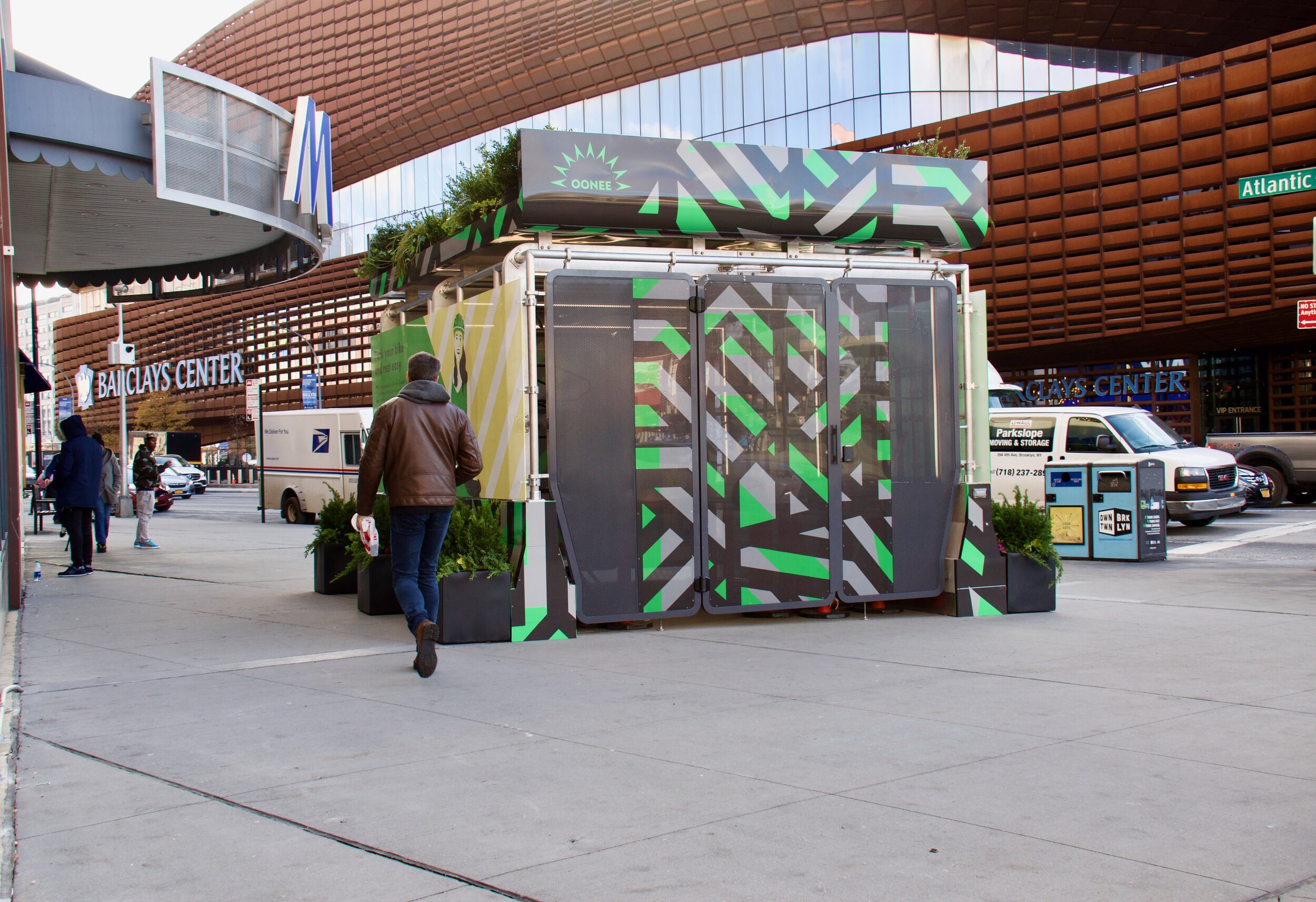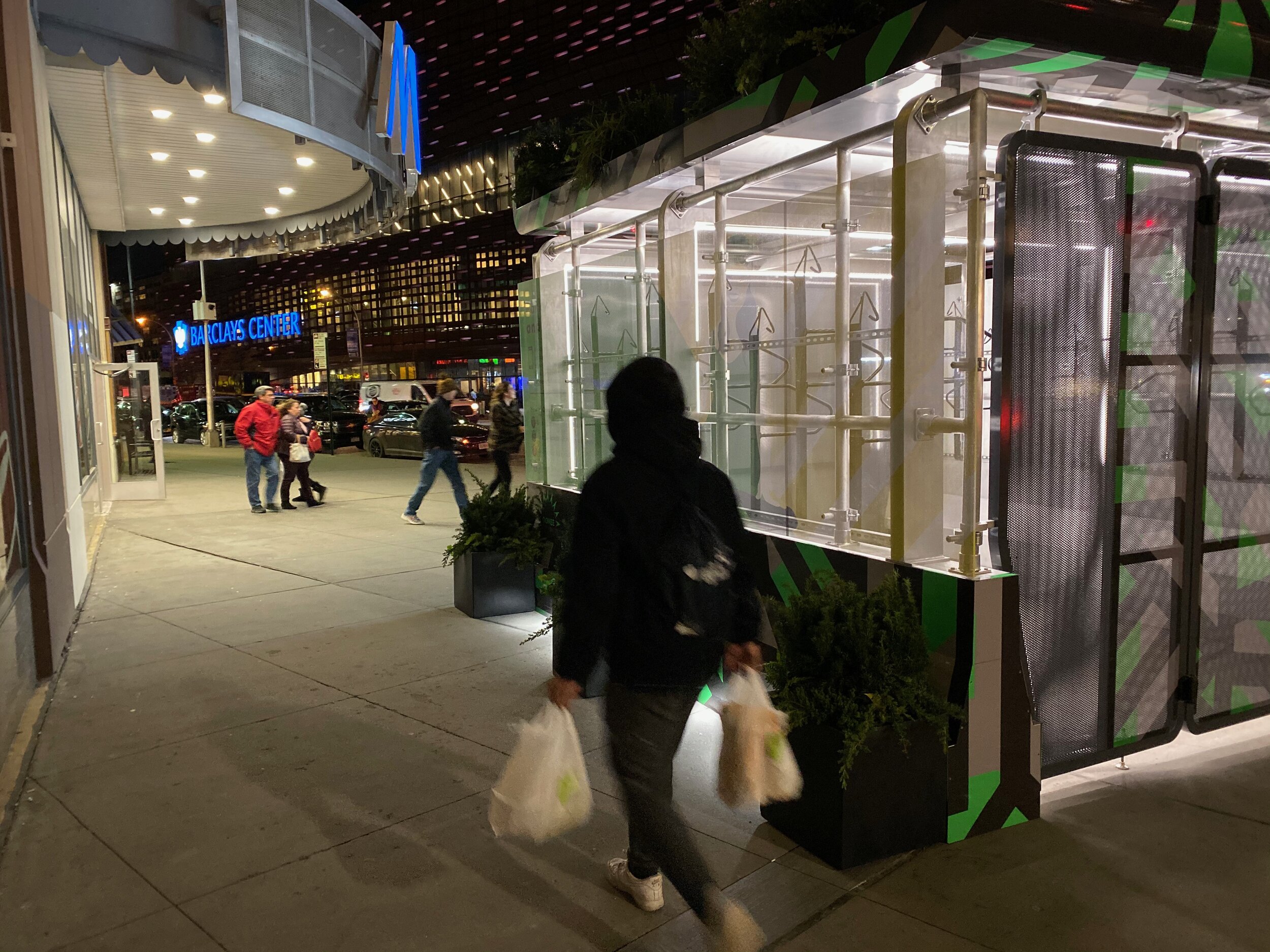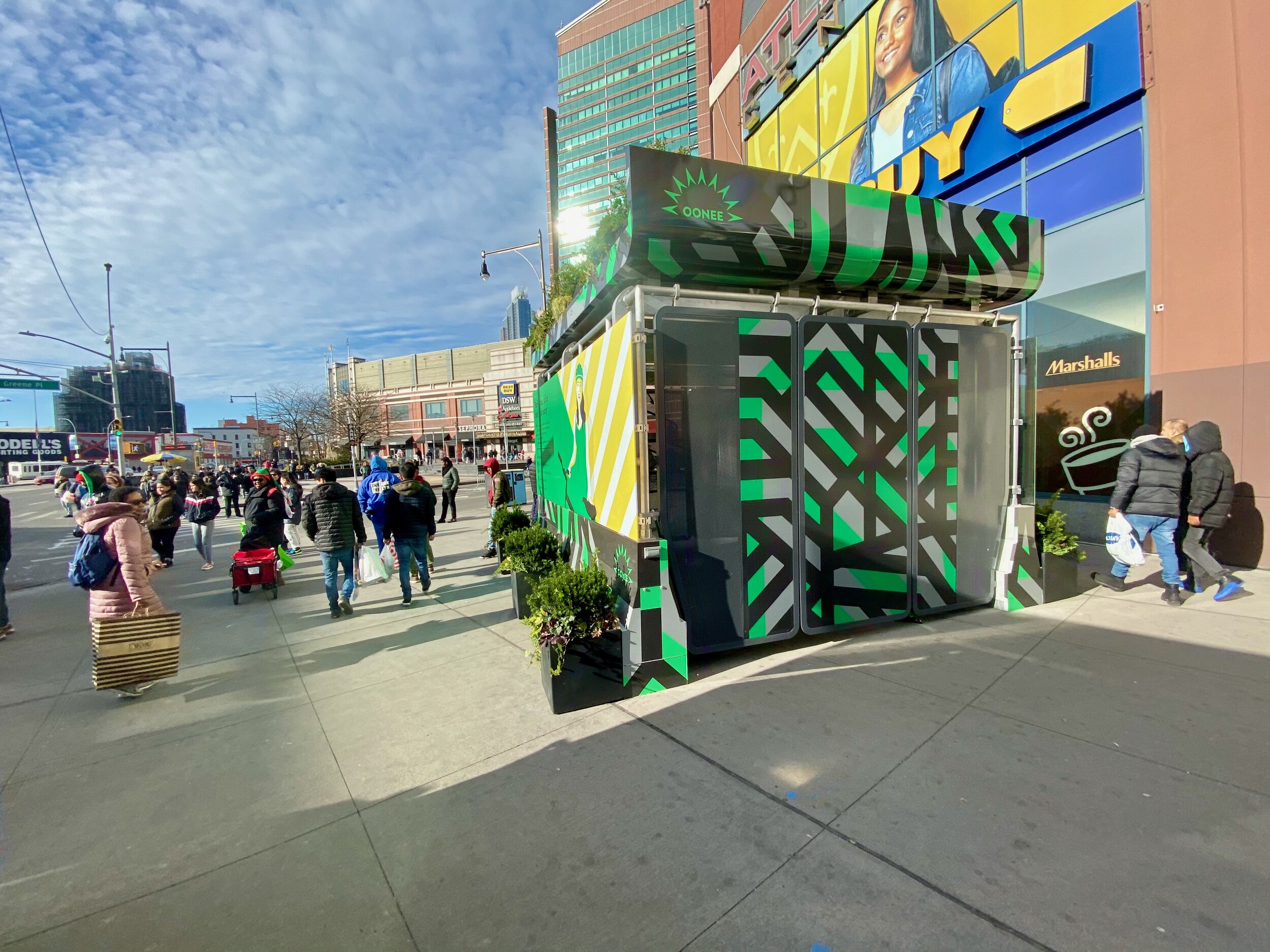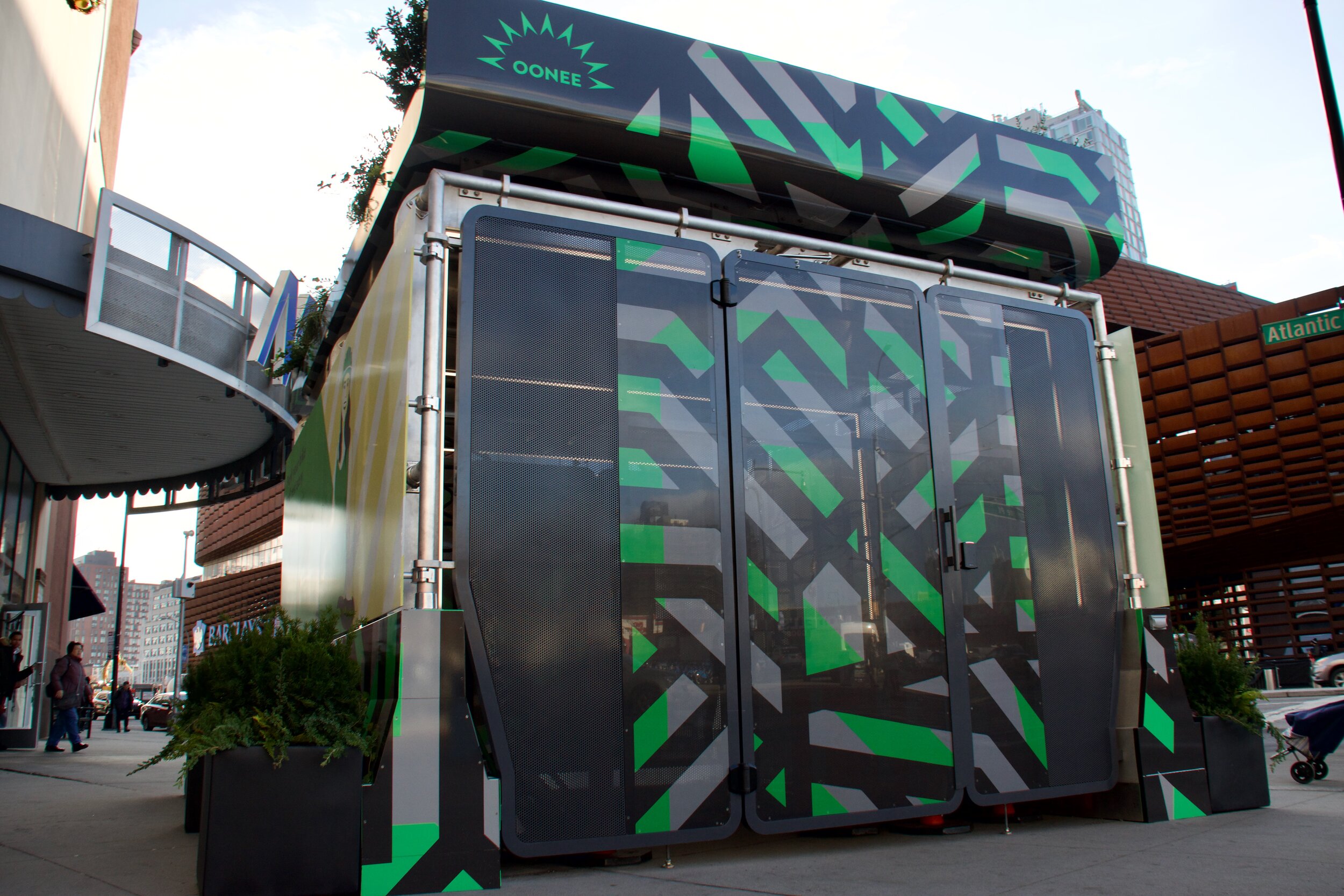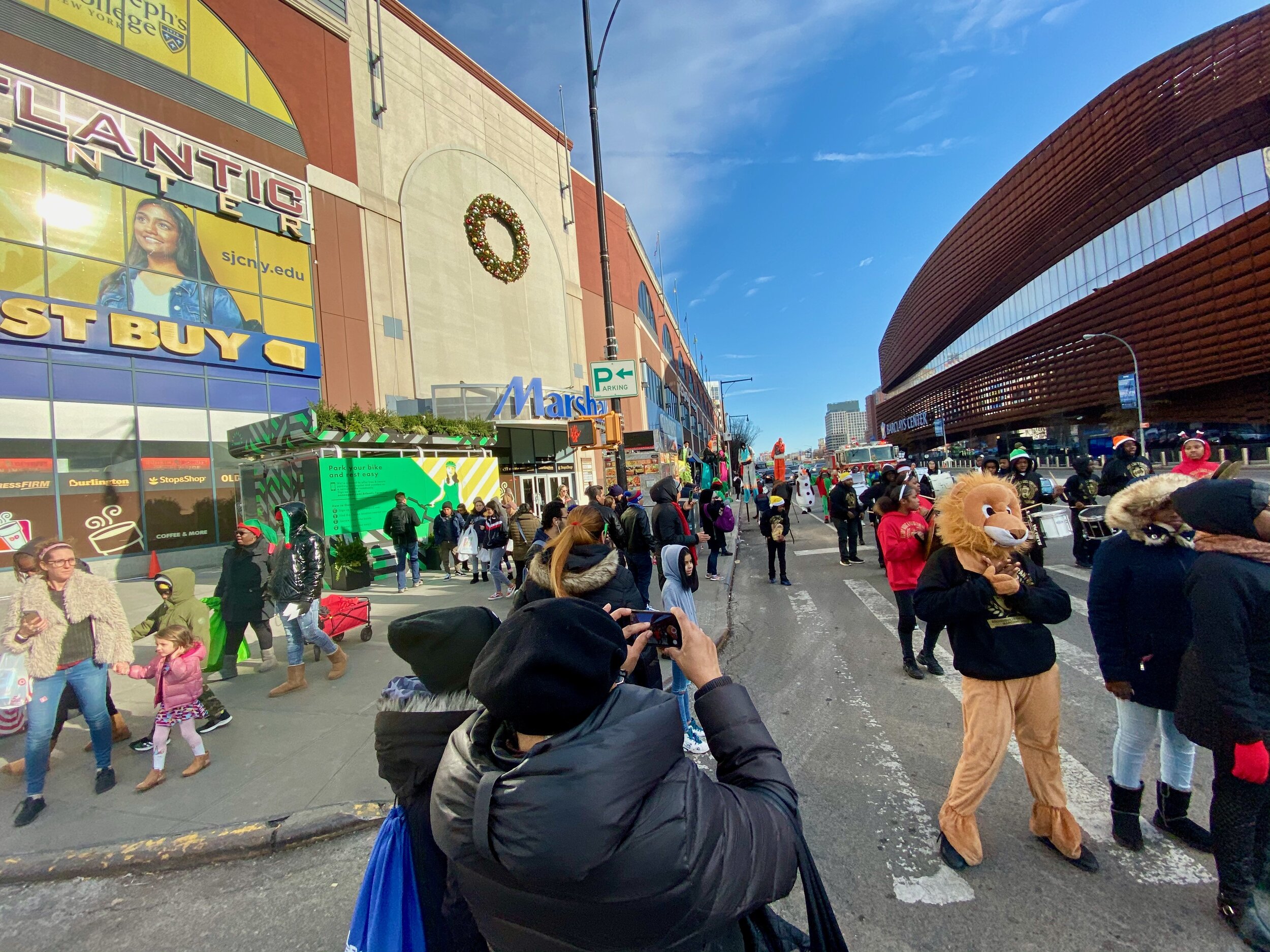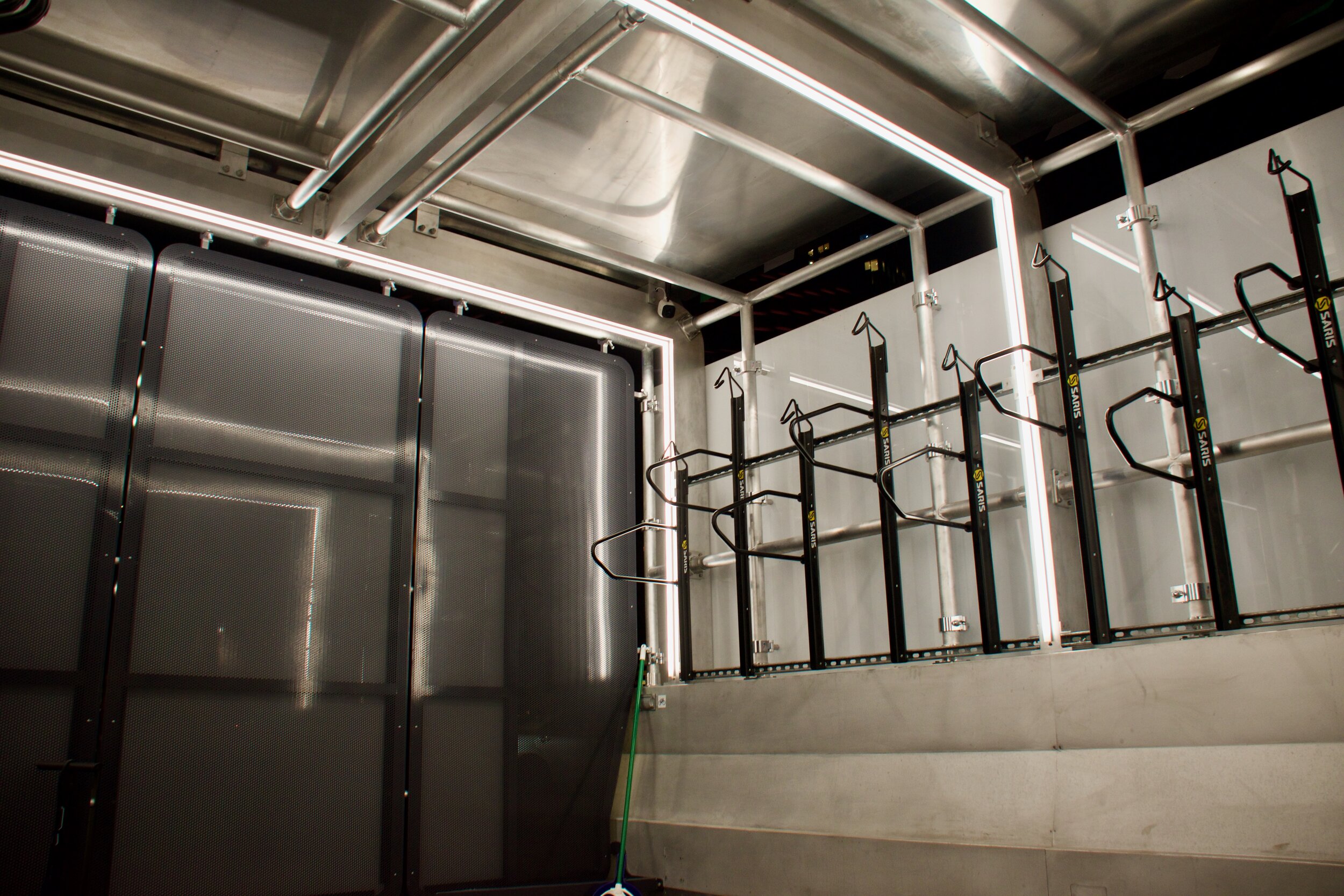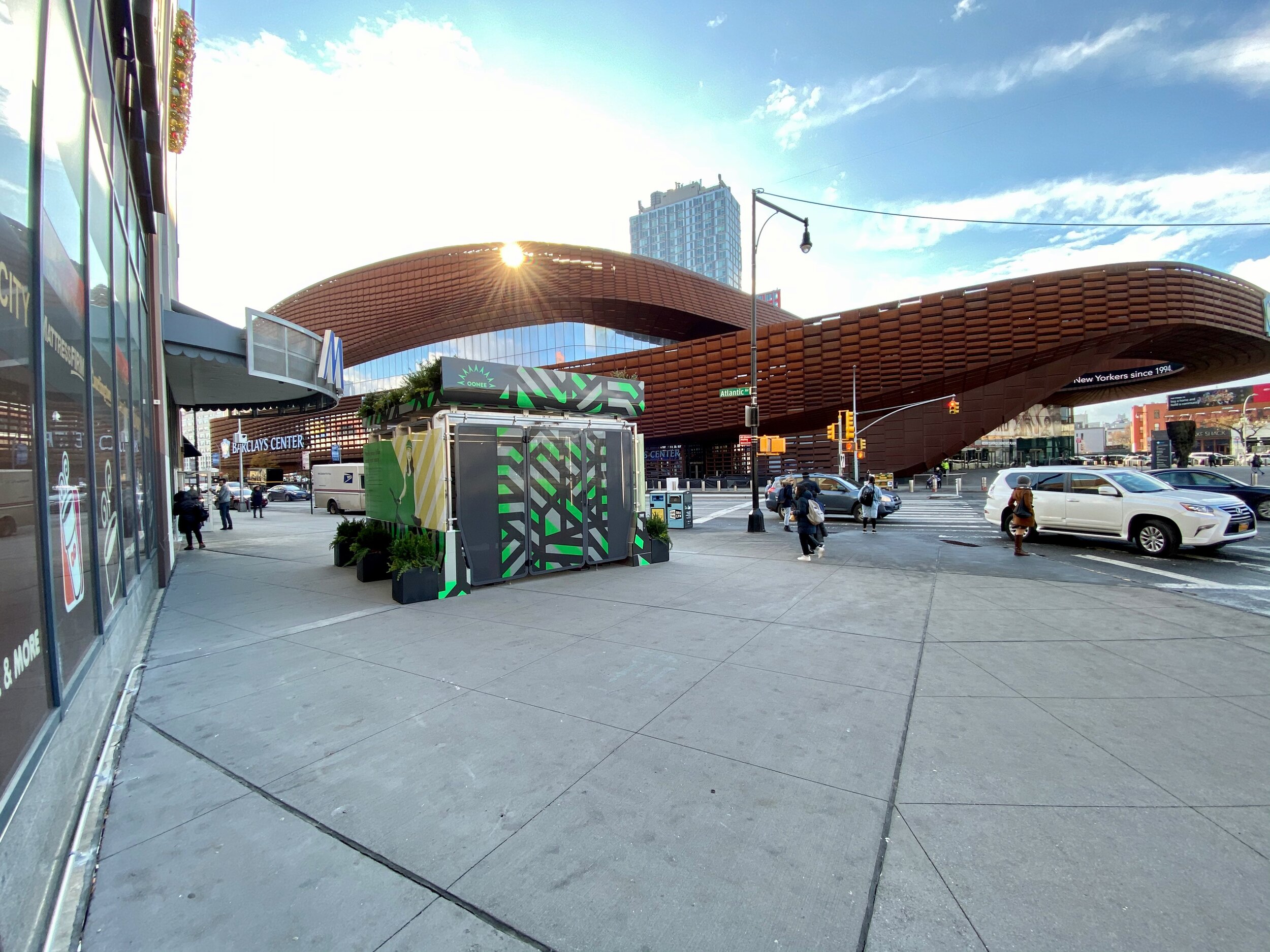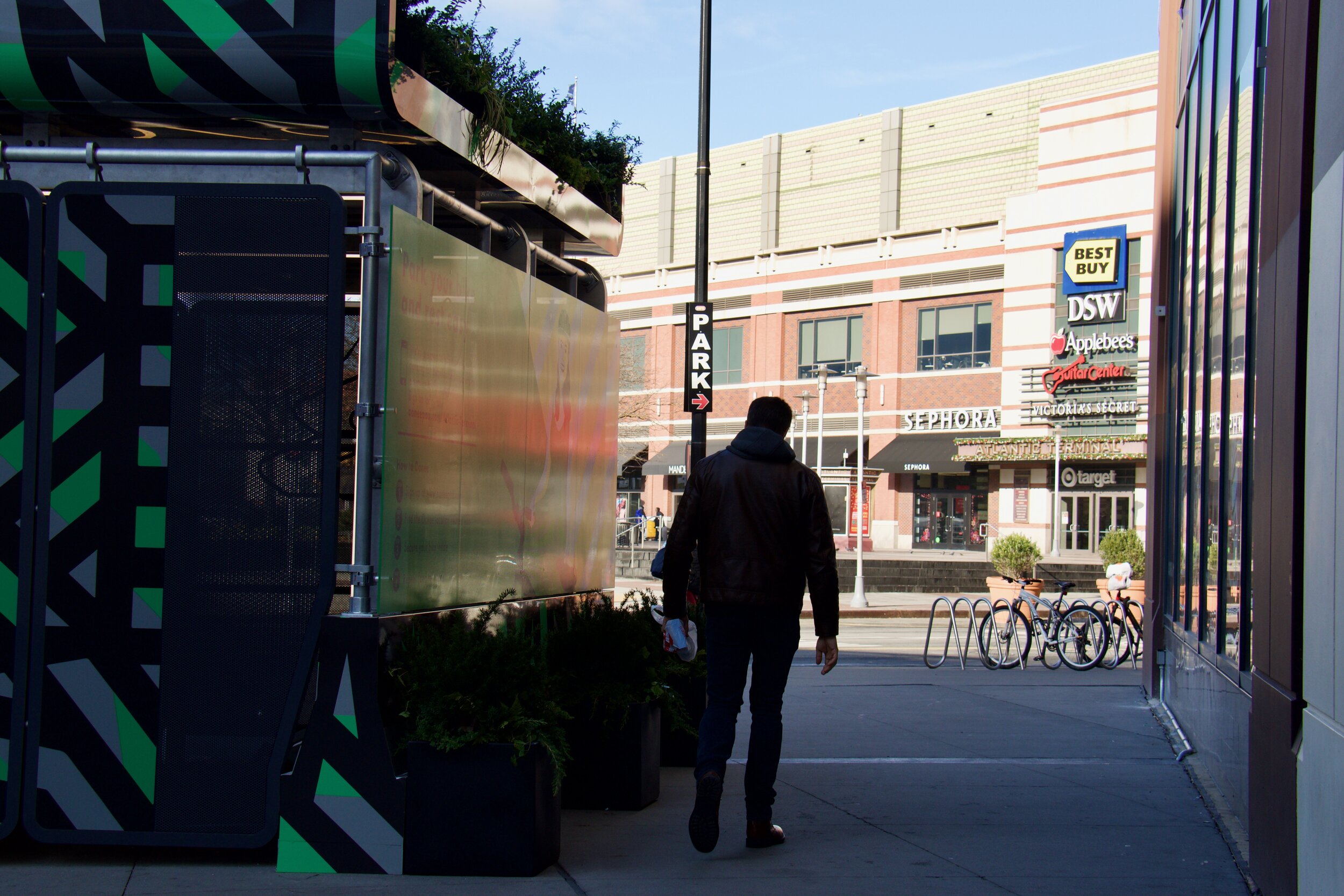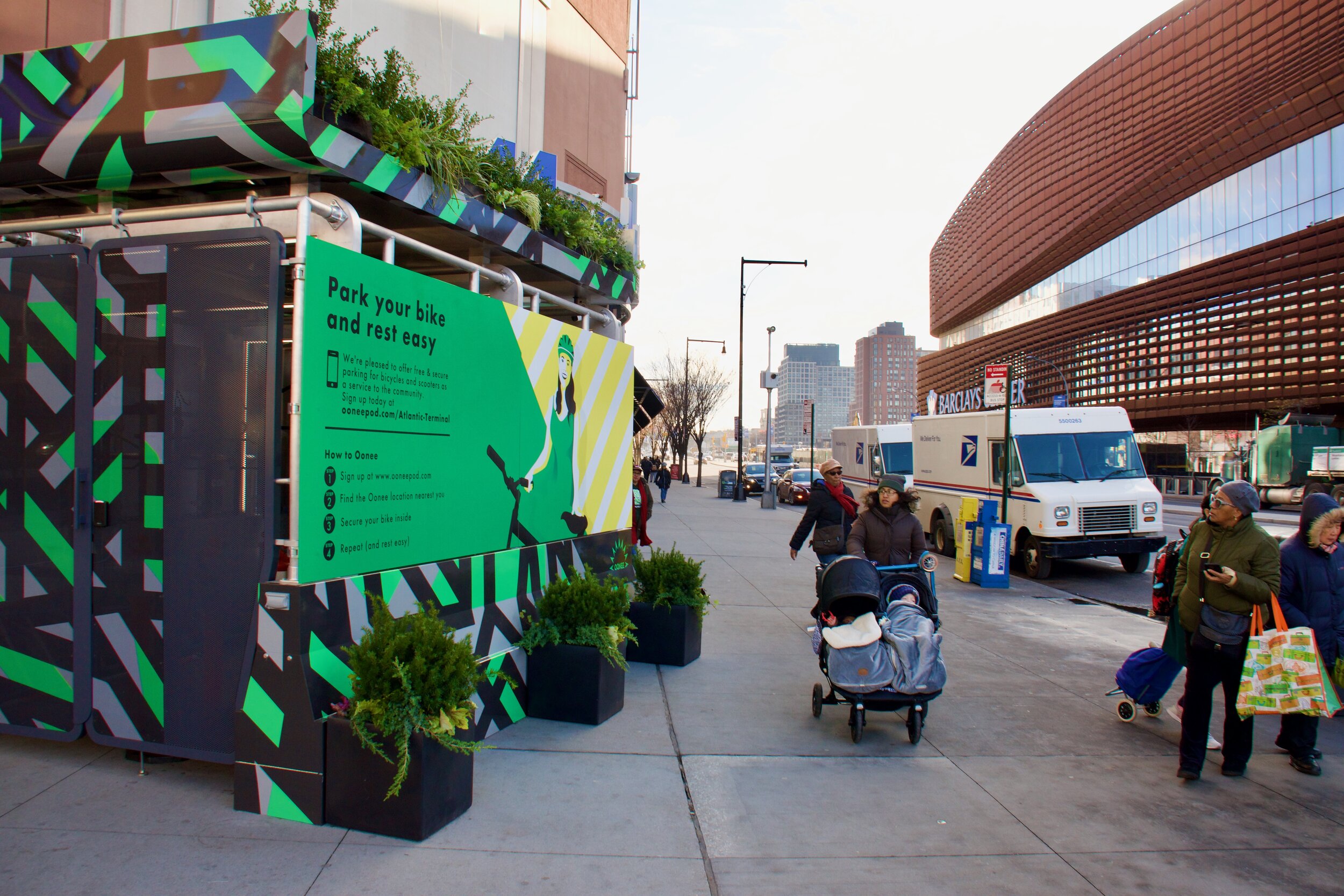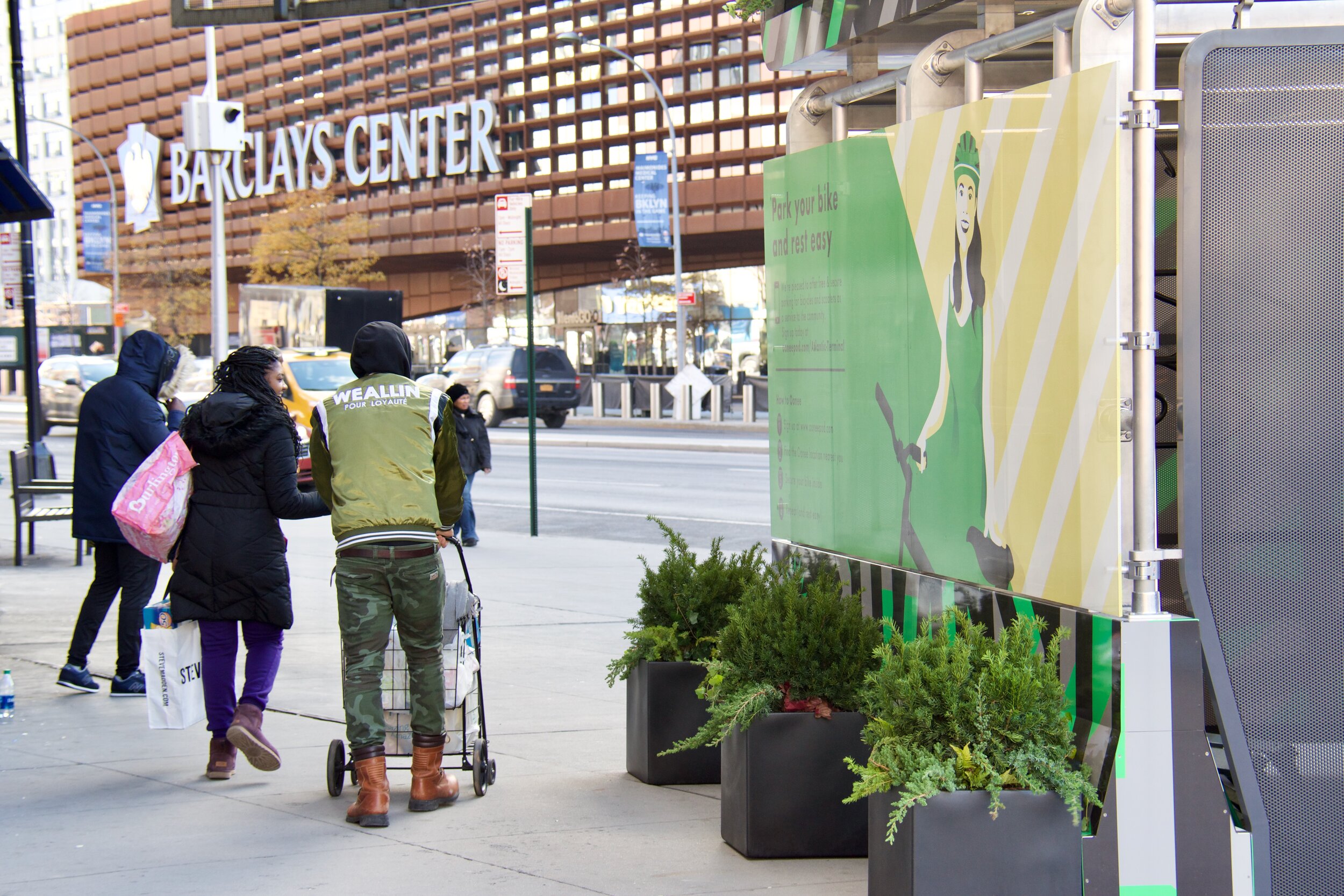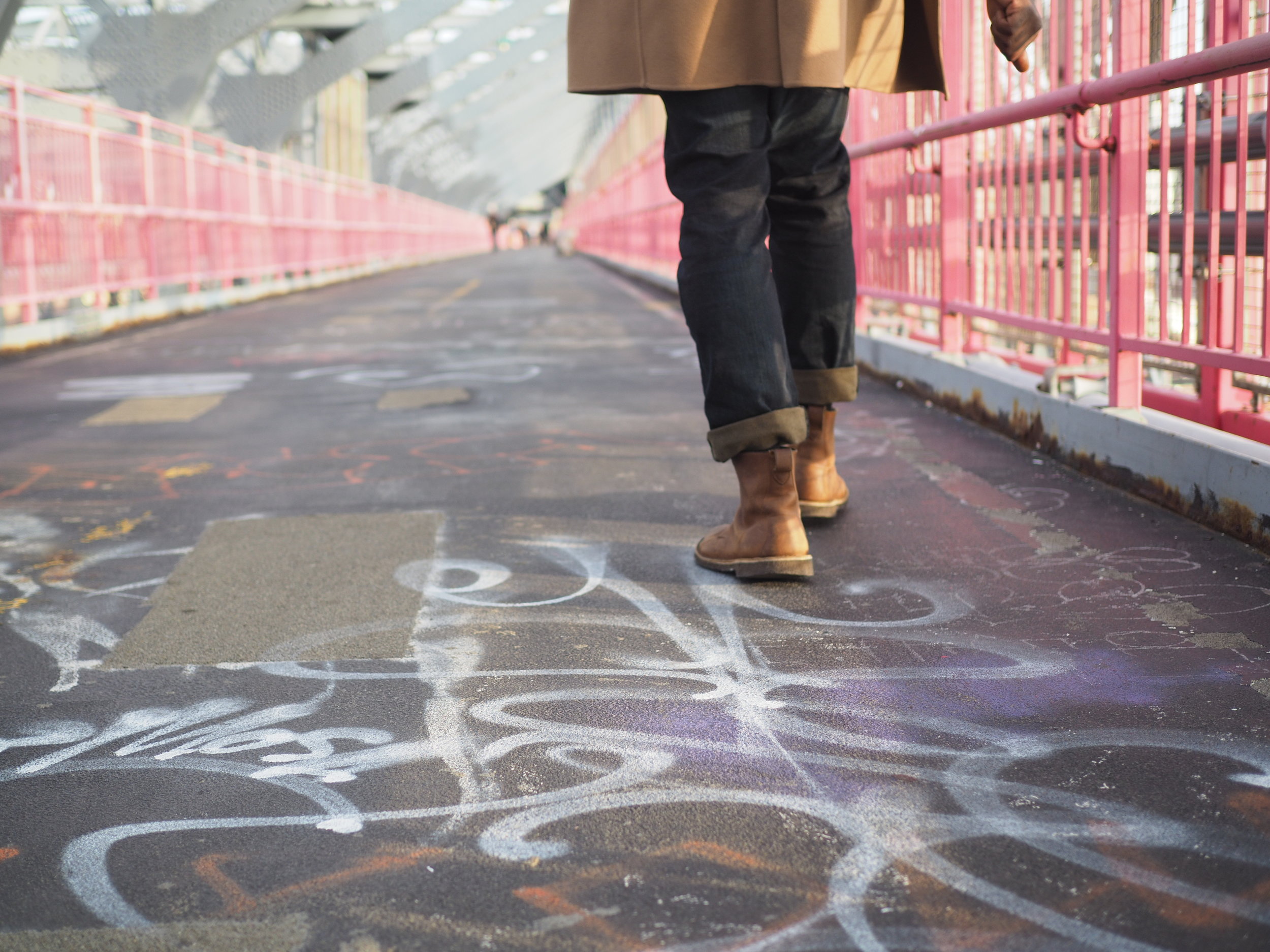
transportation
Whether you are commuting to work or traveling for leisure, transportation is a major aspect of our daily lives. Disparities in transportation related issues can adversely impact black urban spaces. Despite the challenges, new solutions are invigorating hope.
First Look: Oonee Atlantic Terminal, Downtown Brooklyn
This new Oonee pod is positioned at Atlantic Avenue and Fort Green Place, in front of the Atlantic Terminal entrance and across the street from the Barclay Center.
The creators of Oonee are not slowing down anytime soon. Back in May, we met with co-founder Shabazz Stuart and discussed Oonee’s origins and infrastructure. Recently, we caught up with Shabazz to get an inside look at Oonee: Atlantic Terminal - before the public grand opening later this week. In this question/answer interview style piece, we discussed the company’s community involvement and intergovernmental and business efforts to get this pod running.
Black+Urban: It looks like Oonee is heading to Brooklyn! What made you select this location? Does it hold a special place in your heart?
Shabazz Stuart: Brooklyn absolutely holds a special place in our collective hearts. I was born and raised in Brooklyn, our company is headquartered in Brooklyn, our solution was developed and integrated in Brooklyn, and our beta testing unit was deployed at the Brooklyn Navy Yard for four months. Brooklyn is home for Oonee and we’re so blessed to be back. Atlantic Terminal ownership was the one who reached out to us about a year and a half ago, with an interest to bring secure cycle parking facilities to the property.
Black+Urban: When can we expect to see Oonee at the Atlantic Terminal?
Shabazz Stuart: The kiosk will be open to the public on Friday, December 13th. Installation was completed just last week, and Membership is free to the public.
Black+Urban: What are some of the new designs and technologies that cyclists can expect?
Shabazz Stuart: We’re excited to offer a number of new features within this installation. We have built in outlets for e-bike and e-scooter charging and an air-pump for tires. Users will also notice lights that are 100 percent brighter than our previous installations. Pedestrians will have the ability to charge their phones and mobile devices on the exterior of the kiosk. From a maintenance and operational standpoint, we’ve built an internal irrigation that will automatically water the plantings on the roof.
“The black experience has significant overlap with the urban lifestyle. Here in New York, roughly 1 of 4 people are Black. The same is true in most other large cities like Houston, Philadelphia and Chicago. In our nation’s capital, about half the residents are Black.
Yet, black perspective is largely absent from the planning and design process that is shaping these growing cityscapes. ”
Black+Urban: It has been said that this is your most ambitious project ever - how so?
Shabazz Stuart: The regulatory and permitting challenges at this location were unprecedented for us. Located entirely on private property, this structure is permitted like any other building. This meant hiring an architect to complete a building filing, working with an expeditor, and bringing a general contractor on-board to oversee construction. This process not only added about four months of time to the deployment process, but it resulted in a budget that was 40 percent higher than previous deployments.
Even so, the Department of Buildings had never quite evaluated a building like ours; we’re essentially a storage shed, but with an innovative method of construction, with movable and reusable components. We were, thankfully, able to work with DOB leadership and City Hall to identify an interim permit, which allowed us to deploy quickly. We’re hoping to work with them in the future to ensure that the kiosk can remain in place with minimal red tape.
During night or day, the Oonee pod - Atlantic Terminal fits seamlessly within the urban environment.
Black+Urban: Oonee is at the crossroads of transportation, policy, urbanism, with elements of entrepreneurial and start-up nuances; what has the Black experience lended to navigating these varying disciplines and business structure?
Shabazz Stuart: The black experience has significant overlap with the urban lifestyle. Here in New York, roughly 1 of 4 people are Black. The same is true in most other large cities like Houston, Philadelphia and Chicago. In our nation’s capital, about half the residents are Black.
Yet, black perspective is largely absent from the planning and design process that is shaping these growing cityscapes.
Traditionally urban planning and design have been mostly white. This isn’t surprising as the degrees required for certification as a planner, architect or designer are often unaffordable or out of reach for many working class minorities. The net result, however, is that Black voices are largely left out at the staff level of urban planning conversations.
The same is increasingly true within the emerging urban entrepreneurial field. In the 21st Century, we’re seeing private actors play a larger role in the evolution of the cityscape; for example Lyft operates Citibike, while JcDecaux, an outdoor advertising conglomerate, operates the city’s public bathrooms, bus shelters and Newsstands. LinkNYC was developed by Intersection, a company backed by Google.
More recently, we’ve seen the rapid of micro-mobility companies like Bird and Lime, which also are tremendously impactful to the streetscape.
Here too, Black voices are largely absent. Startup financing is difficult for minorities; less than 1 percent of venture capital monies went to Black entrepreneurs in 2011. Unfortunately, this means that African-Americans can face extreme challenges in getting the funding to launch their urban focused ideas.
If we are to develop smarter, more effective planning solutions for cities; we must incorporate the voices of the communities that will be served by these new solutions.
Though the fundraising journey was difficult for us (we haven’t raised any venture capital dollars as of yet) my experience growing up Black and working class in New York certainly impacts my perspective with Oonee, our approach to product development, and how we entered the market.
For example, one of the company’s most differentiating features is our commitment to affordable pricing for cyclists. While some have asked us to consider steeper prices in excess of $30 per month, I know that many in our community simply will not be able to afford this, especially when secure bike parking is more likely to function as an additive service (we expect our users to still use public transit and bikeshare). Thus, I made it a priority for us to design a model that shifted the financial burden to advertisers and sponsors.
Inside the Oonee pod- Atlantic Terminal includes vertical bicycle racks, security system cameras and LED lights.
Black+Urban: Since we last spoke, your first kiosk at Water-Whitehall was forced to close, can you tell us what happened there? How are you planning to avoid a similar fate at Atlantic Terminal?
Shabazz Answer: Essentially, the Department of Transportation needed time to think through the rules and regulations regarding advertising on the kiosk. We felt that we had been transparent with everyone regarding our sustainability model and our reliance on advertisements to finance the deployment and ongoing operations. After waiting for nearly a year, our time simply ran out. The company was on the verge of insolvency. The deactivation of the Water-Whitehall installation was a very painful and difficult time for us and our community of users. It was hard to say goodbye to the more than 150 people that relied on that installation for their ongoing commuting needs. We definitely look forward to working with the Department of Transportation for a network of installations in the future once there is clarity on our ability to advertise on the kiosk.
To avoid a similar circumstance at Atlantic Terminal, we’ve spent much more time engaging with the community, and local elected officials in advance of the deployment. Though this installation is on private property, we hope the relationships that we’ve built, combined with the merits of the infrastructure itself can help us avoid another deactivation.
Black+Urban: You’ve mentioned that this kiosk has gone through the “building” permitting process, why did you opt for this route? Is this common for structures not occupied by people?
Shabazz Answer: Yes, every structure above a certain size on private property in New York City must be permitted by the Department of Buildings. Moreover, although people don’t live in our structure, it is intended for ongoing public use; people must be able to safely enter, stand inside and exit, which happens dozens of times a day.
Legally speaking, there just isn’t a way around the building permitting process.
Black+Urban: What are some of the challenges with Oonee being considered a permitted building?
Shabazz Answer: The permitting process for a building was intended for much larger, more complex structures, it was definitely a long and expensive challenge for us to put the kiosk through it for the first time, especially since the design had largely been completed. We’re grateful that City Hall, Borough Hall and Speaker Corey Johnson were there to help us navigate the process.
Our kiosk had to conform to zoning and fire code requirements; there was even talk about if we would have to integrate a sprinkler system or bathroom into the design. Ultimately, we were able to work with the Department of Buildings to find a simplified, interim path forward. Despite the small size of the structure, the cost of architects, expeditors and structural engineer certification exceeded $25,000.
The Oonee Team: From left to right, Matt Moates (Operations Manager), Shabazz Stuart (Founder and CEO), Manuel Mansylla (Co-Founder and Creative Director), Yosef Kessler (Operations Manager), and Rashid Sumler (Community Experience Manager).
Black+Urban: What actions can local government take to reduce the barrier to entry for entrepreneurs providing solutions to the built environment?
Shabazz Stuart: We hope the popularity and success of the installation will encourage the New York City council to introduce a streamlined process for permitting these types of structures. One simple permitting and rules process for bike parking infrastructure on public and private property will make it much more affordable to install solutions like Oonee on public and private property.
In the long term, we hope the City will incorporate structures like Oonee into the streetscape franchise, thus allowing private operators to bid on opportunities to install a number of locations on public property and right-of-way utilizing advertisements, sponsorship and other revenue models.
Black+Urban: What’s next for Oonee in 2020?
Shabazz Stuart: We’re working with our public and private partners to bring a number of new locations to the New York region. We hope to have some announcements soon.
Join us next Friday December 13th at 4pm, along with Brooklyn Borough President Eric Adams, City Council Majority Leader Laurie Cumbo and The Office of the City Council Speaker Corey Johnson as Oonee officially launches Brooklyn's first secure parking & service hub for bikes! Please click here to RSVP.
Oonee
Company Profile
Founders: Shabazz Stuart and J. Manuel Mansylla
Active Locations: Downtown Brooklyn, NY and Journal Square, Jersey City, NJ.
For More Information, please visit Oonee’s website.
Instagram: @ooneepod
All photos are courtesy of Shabazz Stuart
Provide Comments on our Social Media Platforms Below!
Oonee pod standing defiantly, yet welcoming, as a win for Brooklyn residence and commuters.
Oonee: The Next Cool Thing for Urban Transportation
+ T R A N S P O R T A T I O N
Oonee: The Next Cool Thing for Urban Transportation
By: Byron Nicholas, AICP - May 9, 2019
An Interview with Oonee’s Co-Founder Shabazz Stuart
Black + Urban had a wonderful opportunity to interview Shabazz Stuart, Co-Founder of Oonee. During an exclusive tour at one of Shabazz’s Oonee pods in Downtown Manhattan, we were given an inside look at how Oonee provides a unique and innovative service to urban transportation while providing additional public amenities complimented by a stellar aesthetic to the urban realm.
So what exactly is Oonee? According to Ooneepod.com, Oonee is “a smart, modular, customizable pod that provides secure parking for scooters and bicycles as well as public space amenities.”
The following is based on the content from the interview between Black + Urban’s Byron Nicholas and Oonee’s Shabazz Stuart.
Black + Urban: What lead to the conception of Oonee?
Shabazz: I grew up in New York and I have a great appreciation for its transit system. I love its infrastructure and mobility. I began riding my bike in Boston for college and then in New York; majority of the time it was for work. The problem was that I would get my bike stolen quite often. The fear of bike theft and bike vandalism was the primary fear that people had when using their bikes in the city. I started to wonder why an obvious and pervasive problem didn’t have a solution. Why weren’t there parking for bikes that would be safe and secure? And unfortunately, that’s a major reason why people don’t bike in the city. When my bike was stolen in 2015, I didn’t get another one until 2017.
My team started to think through all the reasons as to why cities don’t have this type of infrastructure, and we aren’t talking about one, two, three or four but hundreds. People want infrastructure that’s attractive, pretty, and iconic. However, they do not want to pay for it, nor do they want to finance it. We realized there was a conflict that needed to be solved. We needed to have infrastructure that was scalable, replicable, duplicable and deploy very quickly but wasn’t one size fix all.
The idea to include infrastructure to park our bikes safely and securely came to us back in 2015. Incorporating a structure that was identical wouldn’t fly. We would need an adaptable and malleable structure that can fit into unique spaces.
Black + Urban: How did your team come up with the name ‘Oonee’?
Shabazz: The name was conceptualized at the last minute. In fact, we were going to go with another name. My colleague who was visiting Japan at the time, called me. He said, “I got it, the new name of our product will be “Oonee”. Initially I thought, “What is an Oonee?”, and as he explained the Japanese translation of Oonee: a sea urchin, it made a lot of sense. Sea urchins are animals found on the sea bed throughout the world’s oceans. Typically they are globular in shape, adaptable, defensible, inconspicuous, but yet, alluring.
“We would have people say, ‘I am interested but I wouldn’t want you to drill into my concrete and have it to be permanent infrastructure’, which is how the pods became free standing.
— Shabazz Stuart”
Black + Urban met with Shabazz Stuart in Downtown Manhattan to Speak about his Entrepreneurial Venture with Oonee.
This Oonee Pod’s Interior is Popular with Little Space for Additional Bicycle Parking. Courtesy of IG: @ooneepod
Diagram Displaying the General Components of an Oonee Pod. Courtesy of www.ooneepod.com (You may click on the image to read the text).
Black + Urban: Let’s talk about the Design of Oonee.
Shabazz: It’s more like a Lego set; it can be different, and it can be the same. It’s a modular way to build things on the streetscape level. That journey, that process is how we created what we have today.
We had to find out what our obstacles would be, design wise, finance wise, business model wise, operation wise, to iterate around and incorporate into the product. The idea wasn’t one central point; it was a two- year process where we went through all the obstacles and designed avenues around all the feedback we got. For example, we would have people say, “I am interested but I wouldn’t want you to drill into my concrete and have it to be permanent infrastructure”, which is how the pods became free standing.
We realized that free standing was the way to go. But that created another problem. How do you create balance? How do you allow the structure to support itself, not to blow away in a hurricane, for example? It needs to be flexible – light to transport it, but also you can anchor it in place. So that’s the reason why we incorporated water barriers.
Video: Shabazz Explains Oonee’s Design, Green Infrastructure, Public Amenities, and How to use Oonee.
Shabazz: It is all modular. Think about it less as one structure and more like connected parts. At the foundation you see the waterfilled barrier shape. It is not anchored to the ground. If you take the water out, you can pick it up in less than a day, and it would be as though it was never here. This entire thing, the doors, hooks could be interchanged. They are all interchanged parts. It has a premium look to it, by no accident, because people would say this is a marquee public space and it has to be marquee. When you guys got here, you said you hardly noticed it. That’s kind of the point. To walk by, and have the structure aesthetically compliment the rest of the city.
“It’s sad that we haven’t created more of an understanding for women and minority lead ventures. ”
Black + Urban: Can you speak a little about your experience as a minority entrepreneur?
Shabazz: I am African American, but my team is diverse. Oonee’s other co-founder is Guatemalan. These days, you will rarely find start-ups to be completely minority owned because the shares of your company quickly start to diversify when you start raising money and start to sell ownership of the company.
It’s sad that we haven’t created more of an understanding for women and minority lead ventures.
A woman engages with an Oonee Pod located in a Downtown Manhattan Public Plaza.
Black + Urban: Why do you think there is so few infrastructures that accommodate bicycle, scooters and more “green” forms of transportation?
Shabazz: Being a policy guy myself, I’ve wondered why there weren’t any facilities that would support bike and scooters and make them available to the public. Infrastructure is wired to support transportation. The first problem I noticed was cost; no one wants to pay. The second was aesthetics, the third, operational costs, and fourth, management – we may have to hire a property owner to run this aspect. We’ve decided to create a venture that would capital all those things at once: cost, aesthetics, design, technology, and creating a business model that applied financing for the optics and management.
For More Information, please visit Oonee’s website: www.ooneepod.com/
IG: @ooneepod
All photos are courtesy of Shabazz Stuart
Provide Comments on our Social Media Platforms Below!


